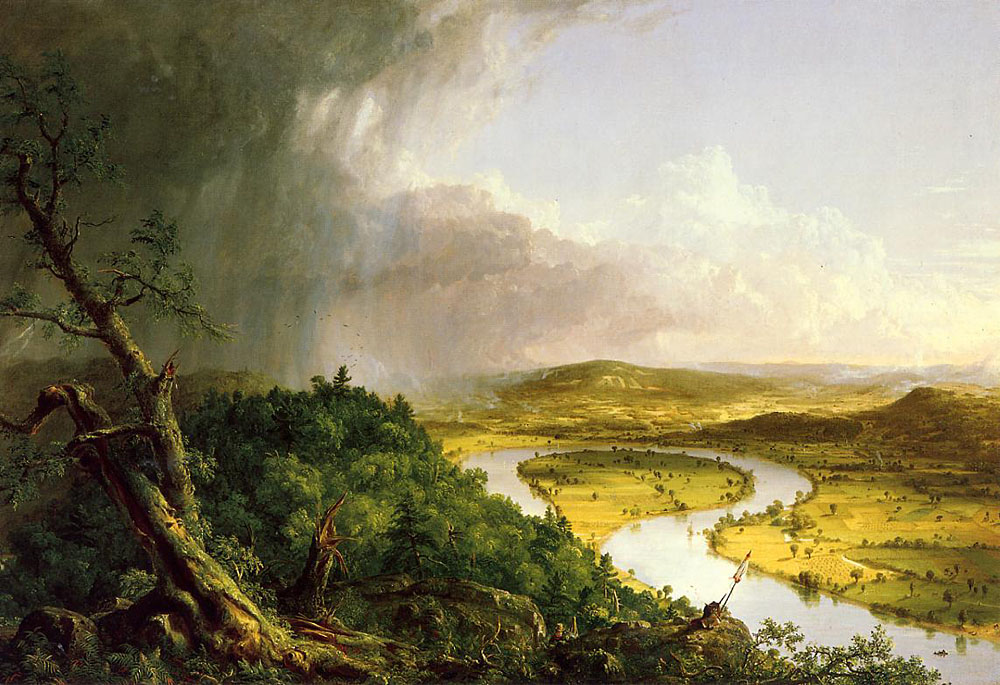One of my favorite wings in the Metropolitan Museum of Art is the American wing. Inside, are massive paintings showing the American landscape and beauty. The Hudson River School is the School of art that is responsible for these early American masterpieces. The Hudson River School founded in the mid nineteenth century, finds its roots in the Romantic period that was occurring in Europe. The Romantic period made landscape painting popular. Before this period, landscape was looked down upon by artists. They believed that paintings should include subjects. Painters, such as Frans Hall, would not have normally painted scenes of merely landscape. He painted for patrons who wanted portraits. Starting in Europe in the seventeenth century with Claude Lorrain, and continuing with John Constable in the early nineteenth century, landscapes began becoming more acceptable. This style of painting travelled to America and resonated there.
During this time in American History, the west had just been opened up to the small country. In 1803, President Thomas Jefferson purchased the Louisiana territory from France, and sent Meriwether Lewis and William Clark to explore the newly acquired territory. By 1853, with the signing of the Gadsden Purchase, we had acquired all of the continental United States through treaties and wars. People were fascinated with all of the newly acquired land. Many people went exploring including the artists. The landscape artists were looking for majestic scenes to paint, and they found them in the untouched land of the west.
I love the paintings for more than just their beauty. In the paintings, there are hints of political agenda. Manifest Destiny, the belief that America is destined by God to spread from sea to sea, was beginning to take root during the nineteenth century. These landscape paintings promoted Manifest Destiny through their use of light. Previously in art, light had been used to shine upon the most important subject, and show that God approved of him. Now light was being used to show that God approved of the nation spreading out to the Pacific Coast.
An example of the Hudson River school is Thomas Cole. He is the founder of the Hudson River school. Cole painted many landscapes among them is View from Mount Holyoke, Northampton, Massachusetts, after a Thunderstorm, or more commonly known as, the Oxbow. He painted this picture in 1836 on oil on canvas. The subject of the painting is the contrast between the domesticated and cultivated lands and the wild lands of Massachusetts. He shows his preference on the two with the use of color. He uses soft hues for the cultivated lands, while he uses dark and menacing colors for the untouched land. The storm is lingering over the wild land, while the domesticated land is bathed in sunlight. This painting was done during time the nation’s desire to expand, and control the vast wilderness in the west.


Wonderful! I think you are the record holder for greatest number of trips to the Met! It will be interesting to see what you think of the DeKooning show.
Lauren, I love that your brought the topic of romanticism into our blog, as it was one of my favorites art styles when I studied European history. Romanticism tried to evoke a powerful emotional sense through the arts, known as the romantic. It also focused a lot on trying to portray the “sublime”, which was thought to be the strongest emotion that the mind was capable of feeling. Romanticism started during the second half of the 18th century and continued and strengthened during the Industrial Revolution. The concept behind Romanticism was brought upon by a revolt against the aristocratic political and social norms that arose from the Age of Enlightenment. It was also a reaction against the scientific rationalization of nature as the sciences were evolving rapidly at this time.
It’s interesting that we can see the the whole Romantic movement was created in response to the disgust with the aristocratic political and social norms. We saw a similar change in social status quo when we went to view the Franz Hals exhibit at the Metropolitan Museum of Arts. Hals saw a growing middle class and decided to fill that gap of art appreciation by giving the middle class access to the arts by working for the emerging bourgeoisie. We saw the emergence of the upper middle class beginning to appreciate the arts, as they hired artists like Hals to paint pictures of themselves. These paintings were used to show off to ones friends that he is money and he is one of the upper class. It gave the middle class the feeling that they live the lavish life on the aristocrats.
It’s interesting to note the difference in the ways that art was produced in reaction to similar social movements. When there was a change in the middle class during Franz Hals’s life, the new middle class wanted to show off their wealth by commissioning artists to paint themselves. When there was a revolt against the political and social norms of the second half of the 18th century, the whole Romantic movement ensued; whereas an emotion was searched for in art rather than the self gratification that the middle class needed when they commisioned Franz Hals.